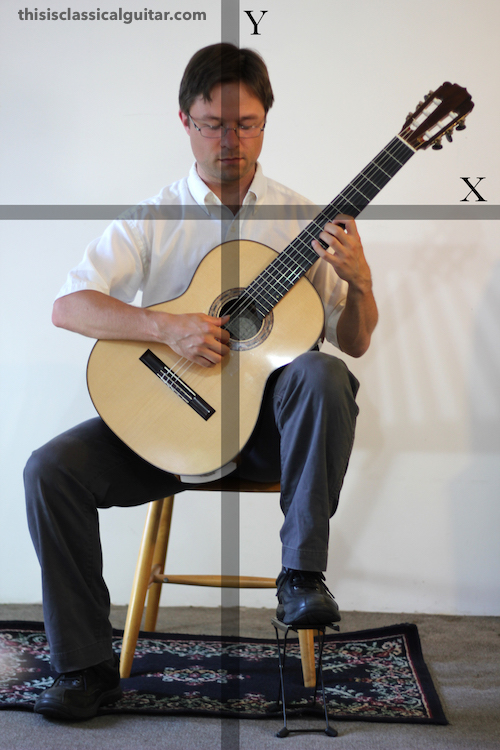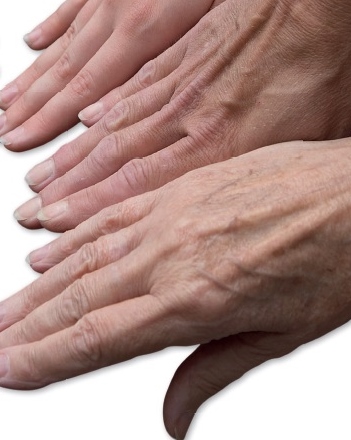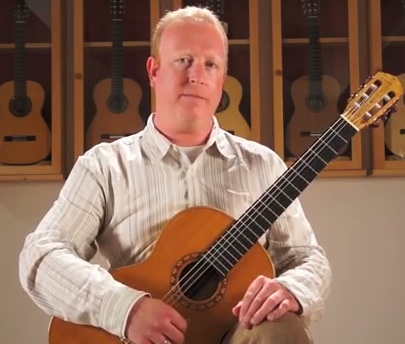Back problems are one of the most common concerns for guitarists aside from hand injuries. Issues range from a sore back due to posture, guitar position, chair height, to footstool use. In this article I will explore back problems in relation to classical guitarists and offer some possible solutions or, at the very least, identify some problems. I am not a doctor or physiotherapist and if you have serious problems you should consult a doctor. There are also specialized programs worth looking into such as medical care, Alexander Technique, or even Yoga. However, this article is really just a reflection based on my personal experience.
Posture & Guitar Position – At the root of the problem is usually the player’s posture and guitar position. Sitting in a natural and ergonomic position takes time, patience, experimentation, and experience. However, you can be assured that with thousands upon thousands of guitarists playing with little in the way of problems that this is a manageable instrument. Your guitar posture should reflect a normal proper sitting posture. Think of your spine as a pillar and your muscles as ‘hanging off that pillar.’ Kind of a gross image but that is the idea, the spine keeps your back supported while your muscles relax. The guitar position is a lifelong pursuit that will continue to change as your skills and body change. However, the guitar will have to fit into your natural ergonomic sitting position if you want to play in a healthy way for a prolonged period of time.
Check out these posts about posture and sitting position for guitar:
- Posture and Sitting Position for Classical Guitar – Video, Photos, Tips, Diagrams
- Also see the Lesson Archive


Foot-Stool – The foot-stool is the common culprit of back problems specifically related to the classical guitar. Since I’ve been playing for over twenty years I may have grown into it so it rarely bothers me. However, if I practice for a few hours in the morning and then teach for six hours I can feel the foot-stool twist my spine. When you elevate one leg a twist in the lower muscles of the back is inevitable. Of course, you can minimize the damage by carefully examining your posture, guitar position, and chair height. Also, a basic understanding of ergonomics is very important. With relaxation, breaks, and stretching, it can be manageable.
Ergonomic Guitar Supports – One of the best developments for classical guitarists has been the ergonomic guitar support which can replace the footstool entirely or at least minimize its destructive use. Finding the correct support for your body is the hard part. I’ve tried at least ten guitar supports and really only prefer two of them so far. Each player will need a specific angle and shape so when they introduce the guitar support they are not messing up thier shoulder relaxation or guitar neck height etc…
Check out my dedicated article on different guitar supports:
Ergonomics All Day Long – As I sit here on the computer typing I can feel my back getting tired because of my poor posture. Since I practice for a few hours a day and also teach for six or seven hours I need to be careful that I don’t ruin my back before I even sit down with the guitar. Heavy use of computers in recent years could be the main problem for many people. The hours of sitting in one static position with bad posture can’t be a good thing. Be mindful of your posture all day long and identify possible contributors to your back pain.
External activities such as driving, sleeping in a wrong position in bed, computer or desk work, heavy lifting, gardening, slouching, etc. can all contribute to back problems.
Chair Height
Sadly, we can’t always choose our chair height. However, finding a chair that is the optimum height for you is one of the keys to saving your back. An adjustable piano bench is likely your best bet for chairs. This way you can experiment and even change the height if you are switching guitar supports or foot-stools. Here’s a crazy nice one if you got the bucks: Walnut Leather Adjustable Piano Bench
Stretching
Along with taking regular breaks to give your back a rest, there are many stretches that can prevent injury, align your posture, and even relieve tension stored in the back muscles. I recommend taking to a specialist, physiotherapist or doctor about this.
I’ll be making a specialized video for stretches in the future. Keep an eye on the blog or subscribe to the newsletter.
Guitar Size
Guitars never used to be so big! Nineteenth century guitars were much smaller which may have allowed more flexibility in posture and guitar position. I, for one, find the modern guitar seriously problematic for my shoulder relaxation (since I’m a shorty!). Therefore, small scale guitars are only logical. Many of my students have switched to small scale guitars which have a shorter string length. This helps especially when playing near the first few frets. Also, luthiers can reduce the width of the neck to make reaches and stretches more manageable which might save the player from reaching out the arm to accommodate a fingering. Many luthiers that build small scale guitars also reduce the size of the guitar body. This is great because many players have to elevate their right shoulder to get the right hand into a good position.
Check out this article I wrote on the pros and cons of small scale guitars: Short scale classical guitars: pros and cons
Length of Playing Time
Not taking breaks and over-practicing can also be a major contributing factor to back pain. As with any repetitive activity, one should remember to take breaks to get up and stretch or walk around. This might also help with mental clarity as well, a small break can increase relaxation and renew concentration.
Teaching All Day
Teaching is a serious issue for many professionals. While demonstrating, using a pencil, or hovering over students, a vigilant posture is often lost for hours at a time. I recommend using a ergonomic guitar support when teaching long hours and remember to put the guitar down more often so you are not in an awkward position when writing or critiquing. Make a conscious effort to always sit properly. In the end this is good for the student as well. If they see you using good posture all the time then they have no excuses to not do the same!
Drink Water
I’ve read that some back problems can be related to, or exasperated by, dehydration. Drink water and reduce your caffeine intake before and during playing. Also, a bit of energy from snacks or juice can help replenish muscles and contribute to concentration and brain power!
RESOURCES:




flamenco posture is the key
Thanks for another fine article. I find it is important also to check the height and location of my music stand. Too high or too low, or too far causes me to push my head forward and give extra work to my neck muscles. This can cause backaches and headaches from referred pain.
Excellent idea WHR! I totally forgot that one!